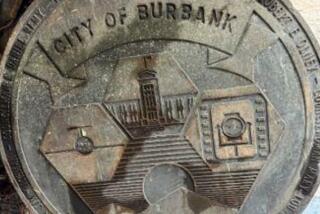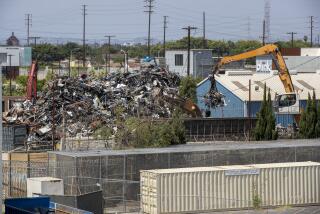Heaps of Junk Metal Bringing Piles of Cash to Company
EUGENE, Ore. — The heaps of steel wheels, rusty nails and dented appliances at Schnitzer Steel’s scrap yard along Highway 99 in west Eugene look like a bunch of junk.
But that junk is worth millions of dollars. The Eugene operation generated about $16 million in revenue in the fiscal year ended last Aug. 31.
Bankrolled by its initial public offering in 1993 and a subsequent offering last month, Schnitzer has renovated its facilities, including the Eugene site, and is looking for new acquisitions. The Portland-based scrap powerhouse wants to grab a bigger share of the world’s growing market for recycled metal.
Schnitzer runs one of the largest ferrous scrap recycling operations in the country and doesn’t face much local competition. In the Pacific Northwest, Schnitzer competes mostly with smaller mom-and-pop operations, said Bill Whitlow, an analyst with Pacific Crest Securities in Seattle.
At home and abroad, the historical image of the big steel’s blast furnaces melting ore from nearby mines has given way to streamlined minimills that melt scrap, instead of ore, in electric furnaces.
The transition began several decades ago, and the world’s scrap consumption continues to grow.
Steel producers in the United States consumed about 40 million tons of scrap a year in the early 1980s and now they use about 57 million tons a year, said Bob Garino, commodities director with the Institute of Scrap Recycling Industries, a Washington-based trade group.
In the 1950s, 5% of raw steel in the United States came from recycled scrap metal, said Tom Zelenka, a spokesman for Schnitzer Steel in Portland. Now the rate is 40%, he added.
Rapidly developing countries in Asia, without scrap supplies of their own, are particularly hungry for recycled metal to create infrastructure and durable goods, industry analysts say. Schnitzer is well positioned to satiate their appetites.
“In China, they don’t really have a lot of refrigerators and autos to melt down, so they’ve got to get it somewhere else,” Whitlow said.
“With deep-water ports in Tacoma, Portland and Oakland, Calif., and strong collection facilities, Schnitzer is in a good position to supply that,” he said.
Schnitzer acquired the Eugene scrap operation and others in Bend, Grants Pass, and White City, from Sessler Steel, a small, privately held company. Two years and $2 million in improvements later, Schnitzer has doubled the amount of scrap, piled high in trucks and rail cars, that rumbles to and from the Eugene yard.
Now, the 70-employee division collects, processes and ships about 90,000 tons of steel scrap and 9 million pounds of nonferrous scrap annually. Schnitzer also runs an on-premises retail business to sell steel remnants to the public. Contractors and sculptors alike shop there.
The Eugene improvements range from the simple to the complex. Schnitzer installed a 3,500-foot fence to secure the 11-acre yard and make it more pleasing to the eye, said David Marco, the facility’s general manager. The company also has invested in the new, timesaving equipment, such as a heavy-duty guillotine shear and a high-speed baler.
The new 800-ton shear, which two people can operate, can do the work of 15 torch cutters, Marco said. It processes up to 15 tons of scrap an hour, five time more material than the shearing equipment it replaced. One worker loads scrap with a crane into the machine. From a perch in a control booth, another worker operates equipment to crush the metal and move it along a conveyor to where a large guillotine chops the steel into 3 foot by 2 foot chunks. The conveyor drops the material directly into rail cars bound for Cascade Steel Rolling Mills, Schnitzer’s minimill in McMinnville.
“The equipment allows us to be more competitive, to handle more material, and to package it to be handled more efficiently,” Marco said.
Schnitzer also invested in a new baler that binds nonferrous metals in cubes for shipment to processors. Using the new baler, two people can complete in one day the work it used to take four people a week to do using old equipment, Marco said. Processors like the compact bales because more of the metal can fit into rail cars and containers, saving on shipping costs, he said.
The new equipment didn’t displace jobs, Marco said. Instead, the company reassigned employees to collection and demolition crews within the scrap metal division, he said.
In its quest for more scrap, Marco is advocating alliances among county sheriff’s department, two companies and scrap yards to implement a new law passed last legislative session. In the past, ugly and dangerous abandoned auto hulks were left untouched because wreckers couldn’t accept them without proof of ownership. When ownership isn’t clear, the new law allows licensed wreckers to demolish vehicles with appraised values of less than $500. One such program initiated last June has collected and recycled 1,500 vehicles, according to the sheriff’s department.
More to Read
Inside the business of entertainment
The Wide Shot brings you news, analysis and insights on everything from streaming wars to production — and what it all means for the future.
You may occasionally receive promotional content from the Los Angeles Times.










